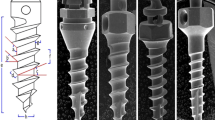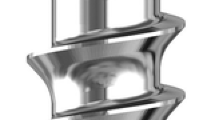Abstract
Purpose
This study investigated the maximum insertion torque value (ITV) of different dimensions of orthodontic miniscrews for primary stability, and further explored the effects of continuous rotation insertion and intermittent rotation insertion methods on the stability of orthodontic miniscrews.
Methods
Six different dimensions of orthodontic miniscrews, three lengths (6.0, 8.0, and 10.0 mm) and two diameters (1.4 and 1.6 mm), were inserted into the artificial bone specimens by using a torque testing machine, and continuous and intermittent rotation insertion methods were applied. There were a total of 12 groups, and each group was composed of five samples. The torque testing machine was used to record the maximum ITV and torque-time curve.
Results
The median maximum ITV of the orthodontic miniscrews in the 12 groups ranged between 11.5 and 23.7 N cm. In orthodontic miniscrews of 1.6 mm diameter, regardless of the insertion method, the ITV increased with length. For orthodontic miniscrews of 1.4 mm diameter, there was no statistical difference in the maximum ITV regardless of the inserted method as the differences in length were negligible (only 2.0 mm). Furthermore, there was no statistical difference in the maximum ITV required for the continuous rotation insertion and intermittent rotation insertion methods between inserting orthodontic miniscrews of similar dimensions.
Conclusion
The maximum ITV mostly increased with the increase in the diameter or length of the orthodontic miniscrew. There was no statistical difference in the maximum ITV required for continuous rotation and intermittent rotation insertion methods.




Similar content being viewed by others
Data Availability
The data sets used and analyzed during the current study are available from the corresponding author upon reasonable request.
References
Cons, N. C., Jenny, J., Kohout, F. J., & Jotikastira, D. (1989). Utility of the dental aesthetic index in industrialized and developing countries. Journal of Public Health Dentistry, 49, 163–166.
Krishnan, V. (2007). Orthodontic pain: From causes to management—a review. The European Journal of Orthodontics, 29, 170–179.
Yu, J.-H., Huang, H.-L., Liu, C.-F., Wu, J., Li, Y.-F., Tsai, M.-T., & Hsu, J.-T. (2016). Does orthodontic treatment affect the alveolar bone density? Medicine, 95, e3080.
Chen, C.-H., Chang, C.-S., Hsieh, C.-H., Tseng, Y.-C., Shen, Y.-S., Huang, I.-Y., Yang, C.-F., & Chen, C.-M. (2006). The use of microimplants in orthodontic anchorage. Journal of Oral and Maxillofacial Surgery, 64, 1209–1213.
Park, H.-S., Lee, S.-K., & Kwon, O.-W. (2005). Group distal movement of teeth using microscrew implant anchorage. The Angle Orthodontist, 75, 602–609.
Papadopoulos, M., Papageorgiou, S., & Zogakis, I. (2011). Clinical effectiveness of orthodontic miniscrew implants: A meta-analysis. Journal of Dental Research, 90, 969–976.
Papageorgiou, S. N., Zogakis, I. P., & Papadopoulos, M. A. (2012). Failure rates and associated risk factors of orthodontic miniscrew implants: A meta-analysis. American Journal of Orthodontics and Dentofacial Orthopedics, 142, 577-595.e577.
Nienkemper, M., Handschel, J., & Drescher, D. (2014). Systematic review of mini-implant displacement under orthodontic loading. International Journal of Oral Science, 6, 1–6.
Stanford, N. (2011). Mini-screws success rates sufficient for orthodontic treatment. Evidence-Based Dentistry, 12, 19–19.
Leo, M., Cerroni, L., Pasquantonio, G., Condò, S., & Condò, R. (2016). Temporary anchorage devices (TADs) in orthodontics: Review of the factors that influence the clinical success rate of the mini-implants. Clinica Terapeutica, 167, e70-77.
Reynders, R. A. M., Ronchi, L., Ladu, L., van Etten-Jamaludin, F., & Bipat, S. (2012). Insertion torque and success of orthodontic mini-implants: A systematic review. American Journal of Orthodontics and Dentofacial Orthopedics, 142, 596-614.e595.
Wilmes, B., Rademacher, C., Olthoff, G., & Drescher, D. (2006). Parameters affecting primary stability of orthodontic mini-implants. Journal of Orofacial Orthopedics/Fortschritte der Kieferorthopädie, 67, 162–174.
Motoyoshi, M., Hirabayashi, M., Uemura, M., & Shimizu, N. (2006). Recommended placement torque when tightening an orthodontic mini-implant. Clinical Oral Implants Research, 17, 109–114.
Suzuki, E. Y., & Suzuki, B. (2011). Placement and removal torque values of orthodontic miniscrew implants. American Journal of Orthodontics and Dentofacial Orthopedics, 139, 669–678.
Watanabe, T., Miyazawa, K., Fujiwara, T., Kawaguchi, M., Tabuchi, M., & Goto, S. (2017). Insertion torque and Periotest values are important factors predicting outcome after orthodontic miniscrew placement. American Journal of Orthodontics and Dentofacial Orthopedics, 152, 483–488.
Lim, S.-A., Cha, J.-Y., & Hwang, C.-J. (2008). Insertion torque of orthodontic miniscrews according to changes in shape, diameter and length. The Angle Orthodontist, 78, 234–240.
Song, Y.-Y., Cha, J.-Y., & Hwang, C.-J. (2007). Mechanical characteristics of various orthodontic mini-screws in relation to artificial cortical bone thickness. The Angle Orthodontist, 77, 979–985.
Chung, C. J., Jung, K.-Y., Choi, Y. J., & Kim, K.-H. (2014). Biomechanical characteristics and reinsertion guidelines for retrieved orthodontic miniscrews. The Angle Orthodontist, 84, 878–884.
Han, C.-M., Watanabe, K., Tsatalis, A. E., Lee, D., Zheng, F., Kyung, H.-M., Deguchi, T., & Kim, D.-G. (2019). Evaluations of miniscrew type-dependent mechanical stability. Clinical Biomechanics, 69, 21–27.
Kravitz, N. D., Kusnoto, B., Tsay, T. P., & Hohlt, W. F. (2007). The use of temporary anchorage devices for molar intrusion. The Journal of the American Dental Association, 138, 56–64.
Kuroda, S., & Tanaka, E. (2014). Risks and complications of miniscrew anchorage in clinical orthodontics. Japanese Dental Science Review, 50, 79–85.
Reynders, R., Ronchi, L., & Bipat, S. (2009). Mini-implants in orthodontics: A systematic review of the literature. American Journal of Orthodontics and Dentofacial Orthopedics. https://doi.org/10.1016/j.ajodo.2008.09.026
Hsu, J.-T., Huang, H.-L., Tu, M.-G., & Fuh, L.-J. (2010). Effect of bone quality on the artificial temporomandibular joint condylar prosthesis. Oral Surgery, Oral Medicine, Oral Pathology, Oral Radiology, and Endodontology, 109, e1–e5.
Hsu, J.-T., Huang, H.-L., Tsai, M.-T., Wu, A.-J., Tu, M.-G., & Fuh, L.-J. (2013). Effects of the 3D bone-to-implant contact and bone stiffness on the initial stability of a dental implant: Micro-CT and resonance frequency analyses. International Journal of Oral and Maxillofacial Surgery, 42, 276–280.
Whang, C., Bister, D., & Sherriff, M. (2011). An in vitro investigation of peak insertion torque values of six commercially available mini-implants. The European Journal of Orthodontics, 33, 660–666.
Kim, Y.-K., Kim, Y.-J., Yun, P.-Y., & Kim, J.-W. (2009). Effects of the taper shape, dual-thread, and length on the mechanical properties of mini-implants. The Angle Orthodontist, 79, 908–914.
Funding
This research was supported by China Medical University and Hospital, Taichung City, Taiwan (Grant Number: 10771709) and China Medical University, Taichung City, Taiwan (CMU110-MF-95).
Author information
Authors and Affiliations
Corresponding author
Ethics declarations
Conflict of interest
The authors have no financial or personal relationships with people or organizations that could be considered inappropriate for conducting this study.
Consent for Publication
Not applicable.
Ethical Approval
Not applicable.
Rights and permissions
Springer Nature or its licensor holds exclusive rights to this article under a publishing agreement with the author(s) or other rightsholder(s); author self-archiving of the accepted manuscript version of this article is solely governed by the terms of such publishing agreement and applicable law.
About this article
Cite this article
Yu, WP., Yu, JH., Wang, SH. et al. The Effects of Diameter, Length and Insertion Method on the Stability of Orthodontic Miniscrew. J. Med. Biol. Eng. 42, 508–515 (2022). https://doi.org/10.1007/s40846-022-00737-0
Received:
Accepted:
Published:
Issue Date:
DOI: https://doi.org/10.1007/s40846-022-00737-0




